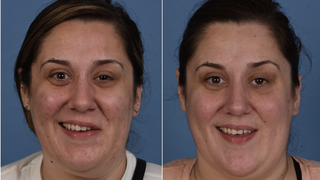Diagnosing TMJ Disorders
After conducting a thorough examination that includes checking the jaw joints for tenderness, rigidity, clicking, and popping, the TMJ specialist may order MRI or CT imaging.
These advanced studies can help doctors identify the precise causes of pain, make more complete diagnoses, and create comprehensive, personalized treatment plans for patients.
Treatment for TMJ Disorders
No single treatment can resolve a TMJ disorder completely, and treatment takes time to be effective. Conservative ways to manage TMJ problems include:
- Eating softer foods
- Avoiding gum chewing and nail biting
- Heat packs
- Relaxation techniques such as deep breathing, meditation, or biofeedback to reduce tension in the jaw
- Medications such as analgesics, muscle relaxants, and anti-inflammatory drugs
Treatments that can improve joint and muscle function include:
- Occlusal splints, custom-made mouth guards that support the TMJ and muscles used for chewing
- Dental braces to correctly align the teeth
- Occlusal adjustments, procedures that prevent teeth from touching each other (occlusion)
- Physical therapy, which can include exercises to improve joint function and reduce muscle rigidity as well as massage, electrical nerve stimulation, and heat/cold therapy
- Oral surgery, which may be necessary with severe TMJ conditions to investigate the source of pain, remove inflamed tissue, repair the joint, or realign the jaw
UT Southwestern’s neurologists, neurosurgeons, and pain management specialists also treat patients with TMJ-related facial pain. Treatment for nerve injuries may include medication and surgery.











